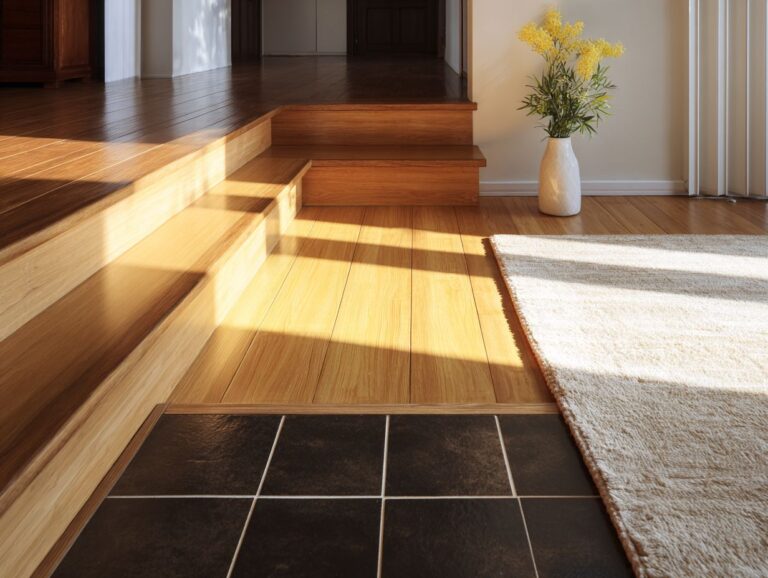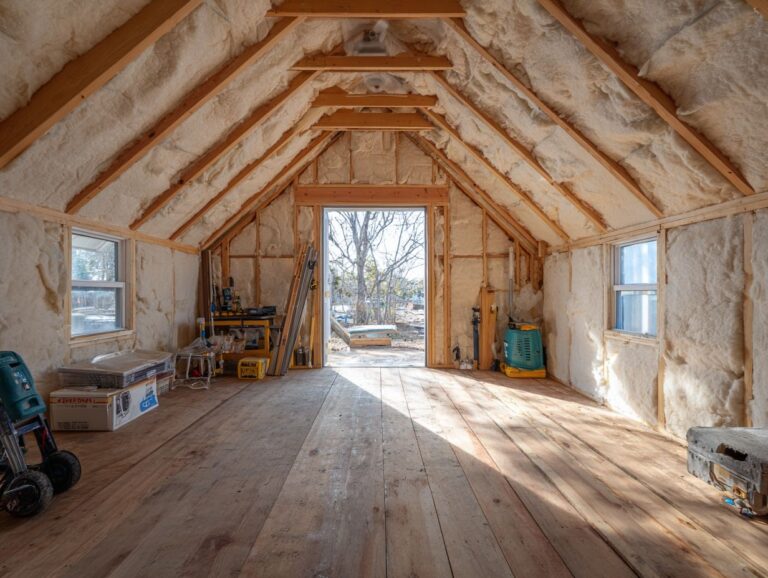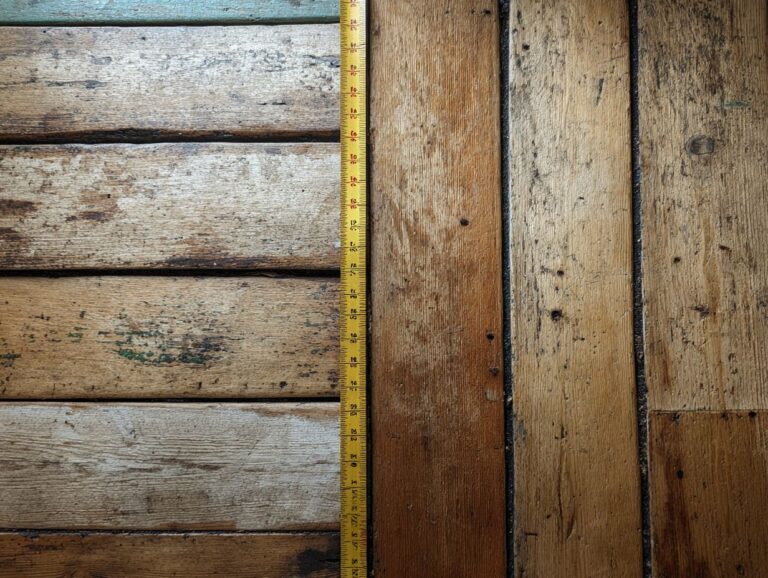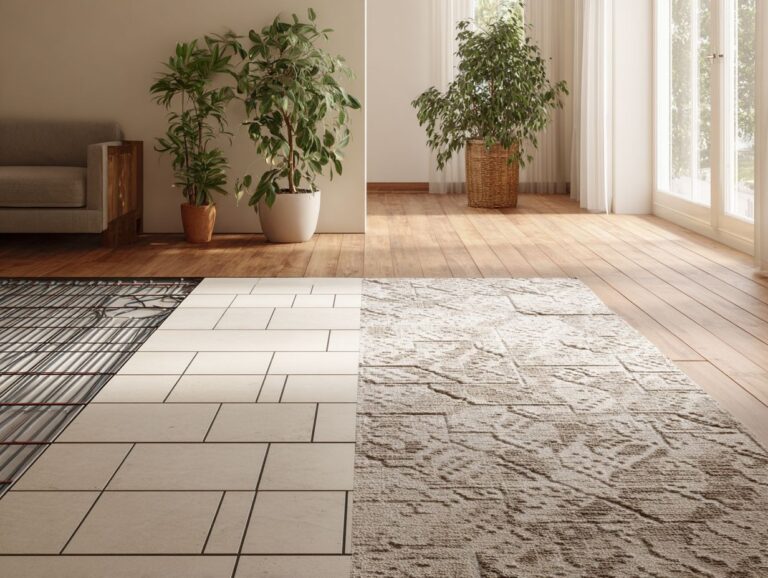LEED Points from Flooring Choices – Green Building
Picking the correct flooring can greatly affect your progress in achieving LEED certification. Using information from the U.S. Green Building Council and specialists such as Sherwin-Williams, this article looks at how flooring materials affect your building’s impact on the environment. Learn about the LEED points you can earn with sustainable flooring options, helping you meet your green building targets and improve your interior design. Knowing these elements will help builders and designers make informed decisions for a greener planet.
Key Takeaways:
Contents
- LEED Certification Categories
- Types of Sustainable Flooring Options
- LEED Points Allocation for Flooring
- LEED Flooring Points Statistics
- Impact of Flooring Choices on LEED Points
- Case Studies of LEED Projects
- Challenges in Achieving LEED Points through Flooring
- Frequently Asked Questions
- What are LEED Points and how can flooring choices impact them?
- Can flooring choices earn LEED Points for a building?
- Are all flooring choices eligible for LEED Points?
- How many LEED Points can flooring choices contribute to a building’s overall score?
- Can LEED Points be earned for both new construction and renovation projects?
- Is it necessary to use only sustainable flooring materials to earn LEED Points?
What is LEED?

LEED, developed by the U.S. Green Building Council (USGBC), is a globally recognized certification system that promotes environmentally sustainable building practices.
LEED uses a point-based rating system to evaluate buildings, encompassing various categories such as Sustainable Sites, Water Efficiency, Energy and Atmosphere, and Indoor Environmental Quality.
Projects can achieve one of four certification levels based on their score: Certified (40-49 points), Silver (50-59 points), Gold (60-79 points), and Platinum (80 points and above).
For example, using green roofs and improving energy use can greatly increase a project’s LEED score, supporting both effective resource use and lasting environmental health.
Importance of Flooring in Green Building
Flooring choices significantly impact a building’s environmental footprint, contributing to both indoor air quality and the overall sustainability of the construction.
Choosing environmentally friendly materials is important for reducing pollution and benefiting health.
For instance, bamboo flooring is a sustainable option, as it grows rapidly and is biodegradable. Cork flooring is another excellent choice; it naturally absorbs CO2 and is harvested without harming the tree.
Choosing certified materials like low-VOC carpets or tiles can help buildings earn LEED credits by promoting better air quality. Using these materials makes a building more eco-friendly and promotes a healthier indoor space for people.
LEED Certification Categories
LEED certification is divided into key sections, each focused on making a building more environmentally efficient. Points are awarded for each section.
Overview of LEED Rating Systems
LEED’s rating systems evaluate how well buildings perform in different areas, offering specific methods to achieve certification.
There are different LEED rating systems, such as Building Design and Construction (BD+C), Interior Design and Construction (ID+C), and Existing Buildings Operations and Maintenance (EBOM). Each allocates credits based on specific sustainability practices.
For flooring, BD+C emphasizes using materials with low environmental impact, encouraging the use of sustainably sourced or recycled content. ID+C focuses on indoor air quality, promoting non-toxic flooring options that improve occupant health.
Having this information helps builders and contractors pick flooring that gets the most LEED points for their chosen plan.
Categories Related to Flooring
Some LEED categories are directly connected to flooring, affecting indoor air quality, materials, and resource management.
Flooring choices affect indoor air quality, so it’s important to pick options with low levels of volatile organic compounds (VOCs). Using approved materials from the Carpet and Rug Institute can meet standards.
The Materials and Resources (MR) category emphasizes sustainable sourcing; look for flooring that is recycled or rapidly renewable, such as bamboo.
Consider Life Cycle Assessment (LCA) tools to evaluate the environmental impact throughout the product’s lifespan, helping to make informed decisions that benefit both your project and the environment.
Types of Sustainable Flooring Options
There are different sustainable flooring choices, each with its own advantages and helping to achieve LEED certification because they are environmentally friendly. Related insight: Recycled and Reclaimed Flooring Options Guide
Bamboo Flooring
Bamboo flooring is a fast-growing resource that lowers environmental harm, so it is often chosen for LEED-certified buildings.
Bamboo can grow up to 39 inches within 24 hours and reaches maturity in just three to five years, significantly faster than hardwoods which may take decades. This rapid increase keeps supply consistent and decreases tree cutting.
Manufacturers like USFloors and Teragren offer high-quality bamboo options that contribute to LEED points for sustainability.
To maintain bamboo floors, use a damp mop with a pH-neutral cleaner and avoid excessive water, ensuring they remain durable and beautiful for years.
Cork Flooring
Cork flooring is a green choice that offers great insulation and helps improve indoor air quality and sound.
Cork flooring comes from the bark of the cork oak tree. It can be renewed and breaks down naturally, making it a good choice for living in an environmentally friendly way.
Its natural properties help reduce airborne allergens and regulate humidity, enhancing indoor air quality. Cork can contribute LEED points under the Materials and Resources category, benefiting environmentally conscious builders.
Leading suppliers like Amorim and Corksource often provide certifications, such as FSC or Cradle to Cradle, ensuring the product meets strict sustainability standards.
Using cork in your design makes your space look great and helps with eco-friendly construction.
Recycled Material Flooring
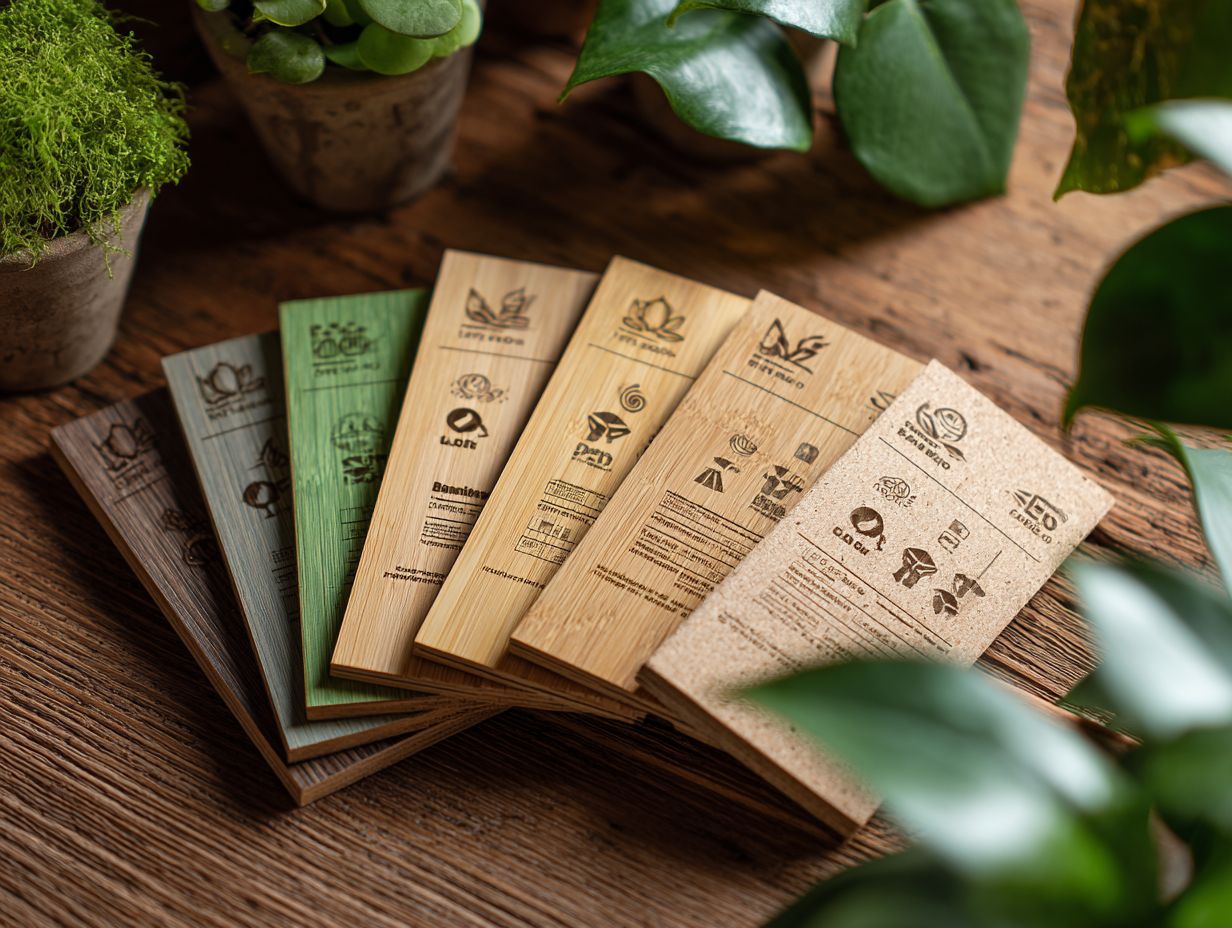
Using recycled materials for flooring provides a practical way to support sustainability by reusing waste in building projects.
Recycled flooring choices like rubber and carpet tiles reduce waste and help achieve LEED certification. For instance, Laticrete’s rubber flooring is manufactured from 100% recycled materials and achieves low VOC emissions, aligning with green building standards.
Meanwhile, Shaw carpets offer products made from recycled plastic bottles, enhancing their environmental credentials. Both options look good and last a long time. They are great choices for environmentally friendly projects and meet LEED standards for reusing materials and reducing waste.
Linoleum Flooring
Linoleum flooring is a biodegradable option that provides durability and ease of maintenance while using renewable materials.
It contributes positively to sustainable building practices by featuring a life cycle that minimizes environmental impact. For instance, linoleum is composed of natural materials like linseed oil, cork dust, and wood flour, which decompose over time, unlike traditional vinyl.
Installing linoleum can earn LEED credits, enhancing its appeal to eco-conscious builders. Leading brands such as Marmoleum offer various styles and colors, ensuring aesthetic appeal without compromising ecological values.
By selecting linoleum, you’re choosing a flooring solution that aligns with green building standards while being practical for long-term use.
LEED Points Allocation for Flooring
LEED points for flooring are given based on various factors such as indoor air quality and how resources are used, which affect the total certification level.
LEED Flooring Points Statistics
LEED Flooring Points Statistics
LEED Certification Points: Certification Levels
LEED Certification Points: Flooring Sustainability Impact
The LEED Flooring Points Statistics offers a detailed overview of the criteria and thresholds involved in achieving different levels of LEED certification, particularly focusing on flooring materials and their environmental impact. LEED, short for Leadership in Energy and Environmental Design, is a well-known international certification for eco-friendly buildings. This dataset explains how flooring can help earn LEED points.
LEED Certification Points are categorized into four main levels based on point ranges that reflect the sustainability and environmental performance of a building. The levels include:
- Certified: Achieving a score of 44.5 indicates the entry-level certification, where buildings meet basic sustainability criteria.
- Silver: A score of 54.5 shows a higher commitment to green building practices, often involving more sustainable materials and resources.
- Gold: At 69.5, Gold level certification reflects significant advancements in environmentally friendly practices, including energy efficiency and sustainable material use.
- Platinum: The highest certification level, requiring 80 points, shows outstanding leadership in sustainability, requiring strict environmental standards and new ideas.
In the context of Flooring Sustainability Impact, the dataset outlines requirements and allowances for flooring materials within LEED certification.
- Non-compliant flooring is allowed a margin of 5%, emphasizing a strong preference for sustainable materials.
- VOC (Volatile Organic Compounds) limits are determined for different materials to keep air quality in check: limits for clear wood finishes are set at 350 g/L, lacquer at 550 g/L, and ceramic tile adhesives at 65 g/L. These limits are designed to minimize emissions of harmful chemicals, promoting healthier indoor environments.
The data highlights the importance of selecting eco-friendly flooring options to reach higher LEED certification levels, supporting environmental sustainability and improving indoor air quality. By following these rules, builders and designers can make a big difference in the eco-friendly construction trend, making sure that buildings are good for the environment and safer for people who use them.
Indoor Environmental Quality (IEQ) Points
Indoor Environmental Quality (IEQ) points are awarded for flooring materials that improve air quality and reduce harmful emissions in buildings.
To earn IEQ points, select flooring with low volatile organic compound (VOC) emissions, ideally below 0.5 mg/m. For example, products like Armstrong’s Natural Choices line or Shaw’s EcoWorx carpet tiles are compliant, utilizing sustainable sourcing practices.
Investigate certifications such as Green Label Plus or FloorScore, which demonstrate adherence to stringent air quality standards. Think about using recycled materials, as they can improve your score and help support environmental sustainability.
Implementing these choices can significantly benefit indoor air quality and overall occupant health.
Materials and Resources (MR) Points
Materials and Resources (MR) points are designated for flooring products that are sustainably sourced, recycled, or made from renewable resources.
To get MR points, make sure your flooring products have certification from well-known organizations. For instance, the Forest Stewardship Council (FSC) certification guarantees that wood is sourced from responsibly managed forests.
Choosing products made from recycled materials, like reclaimed hardwood or bamboo, can improve sustainability. When selecting flooring, consider alternatives like linoleum and cork, which are derived from renewable resources and provide lower environmental impact.
By prioritizing these certifications and materials, you significantly contribute to sustainable building practices.
Energy and Atmosphere (EA) Points
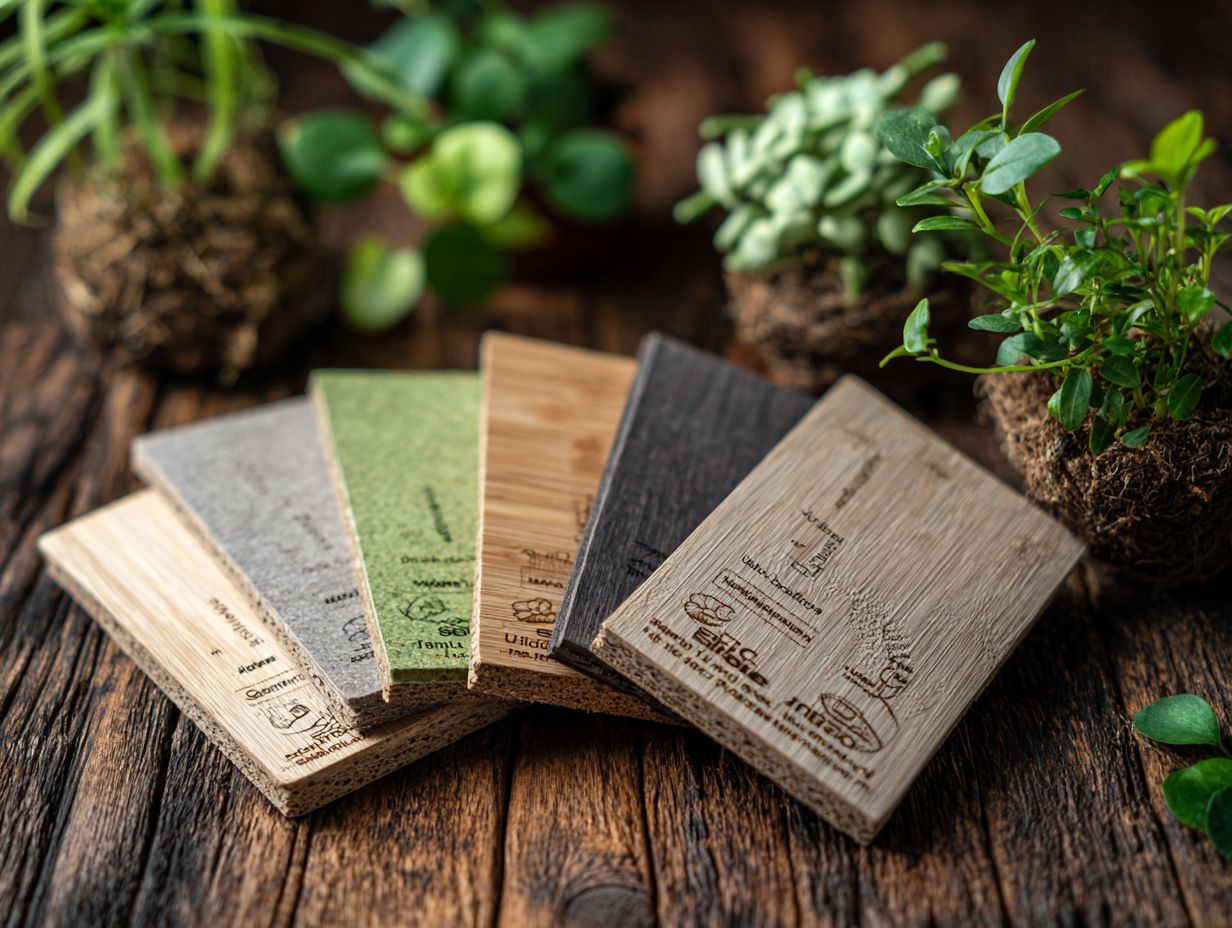
Energy and Atmosphere (EA) points can be influenced by flooring choices that contribute to the building’s overall energy efficiency.
Choosing energy-efficient flooring can significantly lower heating and cooling costs. For instance, materials like bamboo and cork provide natural insulation, reducing the need for additional heating in winter and cooling in summer.
Using radiant heat flooring systems can make heating more efficient by sending warmth straight to the floor, allowing for heat without using a lot of energy. Consider products with low VOC emissions, which contribute to healthier indoor air quality while earning EA points.
Choosing these options lessens energy costs and helps eco-friendly construction methods.
Impact of Flooring Choices on LEED Points
Choosing flooring materials can greatly affect the LEED points a project earns, which determines its certification level.
Life Cycle Assessment of Flooring Materials
A life cycle assessment (LCA) helps evaluate the environmental impact of flooring materials from production to disposal, influencing LEED certification.
In executing an LCA for flooring, assess key metrics, including carbon footprint, resource depletion, and water usage. For instance, bamboo flooring may have a lower carbon footprint due to rapid regrowth, while traditional hardwood can contribute to deforestation.
Reference specific case studies, such as the analysis of vinyl vs. ceramic tiles, where ceramic typically shows less resource depletion but may demand more energy during production.
Use tools like SimaPro or OpenLCA to make gathering and analyzing data easier. This helps create a thorough review to guide environmentally friendly decisions.
Durability and Maintenance Considerations
Durability and ease of maintenance are critical factors in flooring selection, impacting both the environmental footprint and LEED points earned.
Choosing durable flooring materials, such as porcelain tiles or low-VOC vinyl, can dramatically reduce lifecycle costs. For instance, porcelain tiles, with a lifespan of over 50 years, often need minimal maintenance compared to wood or carpet, which require regular refinishing or cleaning.
According to studies, maintaining vinyl floors can consume up to 50% less energy and water than other materials. Choosing durable materials helps with sustainability and earns LEED points for reusing materials and lowering maintenance needs, which supports the project’s aims.
Case Studies of LEED Projects
Case studies of LEED-certified projects provide useful information about how to successfully use sustainable flooring options.
Successful Flooring Implementations
Successful flooring implementations in LEED projects highlight the critical role of material selection in achieving certification goals.
For example, the Bullitt Center in Seattle reached LEED Platinum status by using polished concrete flooring, which reduces waste and increases durability.
The Center for Sustainable Landscapes decided to use Terrazzo flooring. This flooring uses recycled glass and cement, greatly supporting its environmental objectives.
Key lessons learned from these projects include the importance of selecting locally sourced materials to reduce transportation emissions and ensuring materials are free of harmful chemicals.
This method follows LEED standards and improves indoor air quality.
Lessons Learned from Flooring Choices
Analyzing flooring choices in successful LEED projects provides essential lessons in maximizing sustainability and performance.
For instance, using bamboo flooring can significantly reduce the carbon footprint due to its rapid growth and renewability, while cork is an excellent choice for sound insulation and thermal comfort.
It’s important to get these materials from approved suppliers to make sure they follow sustainability standards. Using reclaimed wood improves looks and reduces waste.
Tools like the LEED Online platform can help track material credits and confirm compliance with LEED standards, guiding decision-makers toward eco-friendly flooring options.
Challenges in Achieving LEED Points through Flooring
Getting LEED points with flooring involves difficulties like expenses, finding the right materials, and meeting the standards.
Cost Implications
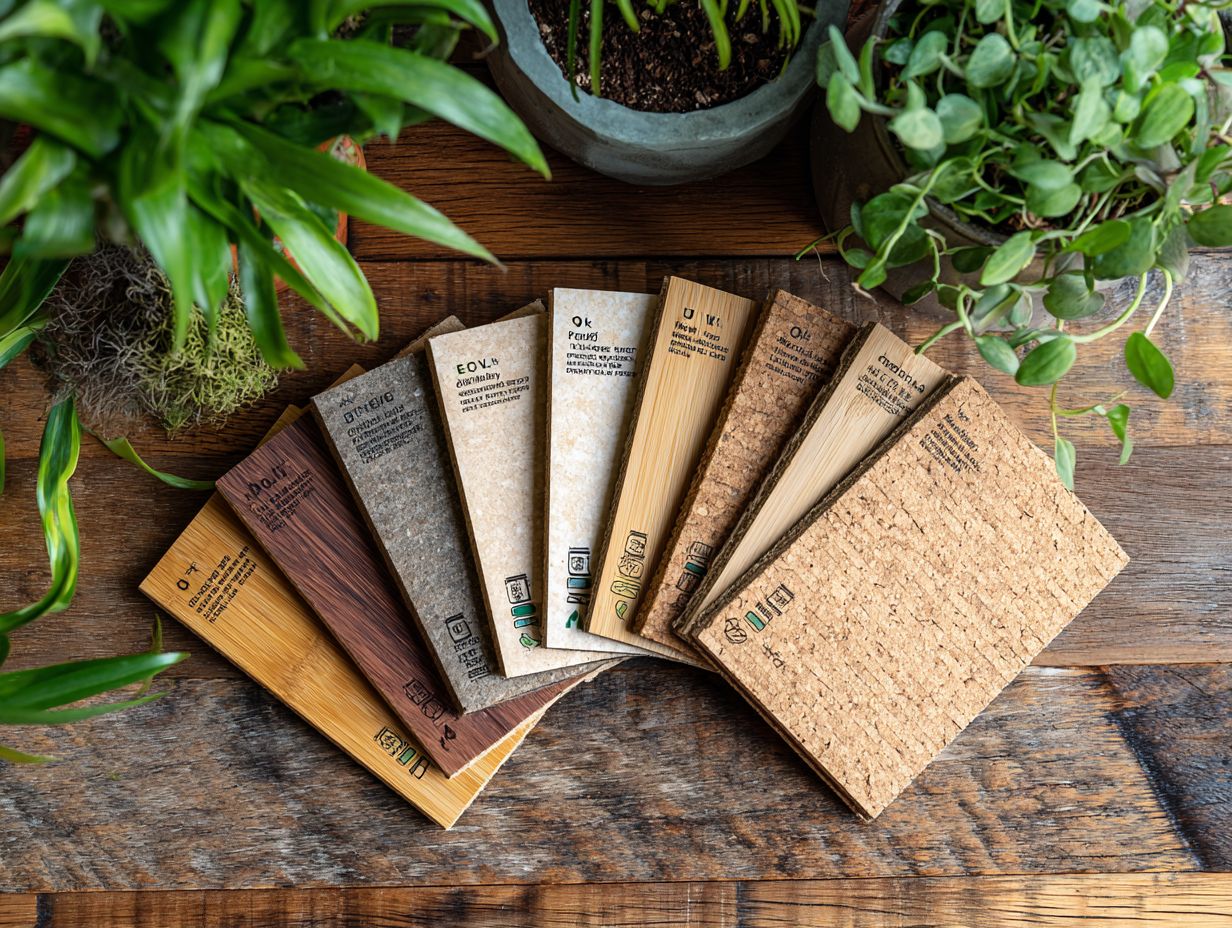
Sustainable flooring options often come with higher upfront costs, which can impact overall project budgets and LEED point allocation.
The long-term savings and benefits can justify this investment. For instance, bamboo flooring may cost around $5 per square foot, compared to traditional hardwood at $8.
Over time, bamboo’s durability can reduce replacement frequency, possibly saving you money on repairs and new installations. Eco-friendly materials often contribute to improved indoor air quality, potentially lowering healthcare costs.
Thinking about budget-friendly sustainable choices involves looking at both the starting costs and the ongoing expenses. This approach can help you save money over time.
Availability of Sustainable Materials
The availability of sustainable flooring materials can be a significant barrier to achieving LEED certification for some projects.
Supply chain problems often cause delays in getting materials such as bamboo or cork, which are popular for being environmentally friendly.
For instance, a project in New York might experience shipment delays from overseas suppliers, pushing back timelines and increasing costs due to last-minute sourcing.
To mitigate these issues, consider local suppliers or alternative materials such as reclaimed wood, which can be more readily available.
Using tools like databases for sustainable materials can make it easier to find options that meet your needs, helping you stay within both your budget and certification goals.
Frequently Asked Questions
What are LEED Points and how can flooring choices impact them?
LEED Points refer to points awarded by the U.S. Green Building Council for projects that meet certain sustainable design and performance standards. Flooring choices can impact these points by contributing to the overall sustainability and environmental friendliness of a building.
Can flooring choices earn LEED Points for a building?
Yes, certain flooring choices can earn LEED Points for a building. Flooring materials that have a lower environmental impact, such as recycled or bio-based materials, can contribute to earning these points.
Are all flooring choices eligible for LEED Points?
No, not all flooring choices are eligible for LEED Points. The U.S. Green Building Council has specific criteria for what qualifies as sustainable flooring materials, and only those that meet these criteria can earn points for a building.
How many LEED Points can flooring choices contribute to a building’s overall score?
The number of LEED Points that flooring choices can contribute to a building’s overall score depends on various factors, such as the type of flooring material, its sustainability features, and the size and scope of the project. It is best to consult with a LEED professional to determine the potential impact of flooring choices on a building’s score.
Can LEED Points be earned for both new construction and renovation projects?
Yes, LEED Points can be earned for both new construction and renovation projects. The U.S. Green Building Council recognizes the importance of sustainability in both new and existing buildings, and flooring choices can contribute to earning points in both types of projects.
Is it necessary to use only sustainable flooring materials to earn LEED Points?
While using sustainable flooring materials is important for earning LEED Points, it is not necessary to use only these materials. A combination of sustainable and non-sustainable flooring choices can still contribute to a building’s overall sustainability and earn points. It is important to find a balance between environmental impact and practicality for the specific project.
